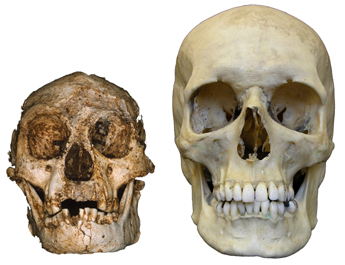 Last October,
a wild discovery was announced: Researchers had uncovered a new hominid species
on a remote Indonesian island. In a large limestone cave on the island of Flores,
the researchers found a skull, jawbone, pelvis and leg bones of an adult female
hominid that they subsequently dated to about 18,000 years ago. In the flurry
that followed the Oct. 28 Nature paper, scientists speculated about whether
the diminutive hominid, referred to in the press as the “hobbit,”
was a new species or whether it was a Homo sapiens with an abnormality
— and what either conclusion might indicate about human evolution.
Last October,
a wild discovery was announced: Researchers had uncovered a new hominid species
on a remote Indonesian island. In a large limestone cave on the island of Flores,
the researchers found a skull, jawbone, pelvis and leg bones of an adult female
hominid that they subsequently dated to about 18,000 years ago. In the flurry
that followed the Oct. 28 Nature paper, scientists speculated about whether
the diminutive hominid, referred to in the press as the “hobbit,”
was a new species or whether it was a Homo sapiens with an abnormality
— and what either conclusion might indicate about human evolution.Researchers have compared the braincase of a new hominid find (left) to modern humans (right), as well as to chimps and other hominids, to try to determine if it is indeed a new species of diminutive hominid that lived 18,000 years ago. Image courtesy of Peter Brown.
By studying the hominid’s relatively small skull and models of its brain, paleoanthropologist Dean Falk of Florida State University in Tallahassee and colleagues decided that this human is indeed a new species, Homo floresiensis, as described in the March 3 Science Express. The team made several 3-D models of the cranial cavity and compared the brain size and structure to those of other animals, including other hominids, chimpanzees and modern humans with microcephaly, a condition involving an unusually small head and mental defects.
Because the skull and bones are extremely fragile, Falk says, the scientists who discovered the H. floresiensis skeleton sent Falk and colleagues a model of the skull based on a CAT scan. From that model, Falk, who has been studying primate brains for 30 years, and her co-workers created a virtual model and a rubber latex model, called an endocast, of the cranial cavity that shows the approximate shape of the brain. “Brains leave an imprint in the braincase,” Falk says, and with the endocasts, “we were able to ‘see’ blood vessels, sutures where the bones of the skull knit together, the brain shape and size.”
The brain size of this H. floresiensis female was about 417 cubic centimeters — about one-third of the average brain size of modern humans, Falk says. The brain size is actually about the same as that of the famed Lucy, an Australopithecus afarensis. But the brain shape of H. floresiensis is quite different from Lucy’s and is actually most like that of Homo erectus, the first species of the genus Homo, Falk says; the shape least resembles that of modern people with microcephaly.
H. floresiensis has brain features “far advanced” for her size, Falk says, such as two large swellings in the frontal lobe (the area of the brain that is important for activities like planning ahead and taking initiative), but a brain size that is “very primitive.” Quite simply, she says, “I’ve never seen anything like this.”
Ralph Holloway of Columbia University in New York City is “not convinced” that H. floresiensis is a new species rather than a H. sapiens with a different type of brain abnormality, such as another variation of microcephaly. In examining an endocast of H. floresiensis, Holloway says he hasn’t seen the same features on the brain that Falk’s team described, noting that any oddities could be “normal” variability. He also measured the hominid’s brain at only 387 cubic centimeters. It could easily be a new species, Holloway says, but “not enough comparison has been done yet.”
“The bottom line is that until we see a second or a third skull, we’re not going to know what the thing is,” says Richard Klein, a paleoanthropologist at Stanford University in Palo Alto, Calif. The cave where H. floresiensis was found has apparently provided modern human skeletal remains in the past, he says, and it would be interesting to know how they relate stratigraphically. The parts ascribed to H. floresiensis, he says, are odd: The body is small, the arms are too long, the teeth are too big, and the head is too small. “Finding one body such as this one might indicate an abnormal modern human,” Klein says. But “finding two would greatly strengthen the case that we’re dealing with a separate human species, and finding three or more would be the clincher.”
Any future finds, however, are “not going to upset the applecart of human evolution,” Holloway says. “We have long known that there must have been other hominids out there,” Klein adds.
Peter Brown, a paleoanthropologist at the University of New England in Armidale, Australia, who was part of the original discovery and research team, says that the team has been back in Indonesia, looking for more examples and evidence of the miniature hominid and have found remains of at least eight H. floresiensis individuals. When analyzing the specimens, however, Brown cautions that it is the combination of traits, not a single trait such as brain size, that can elucidate a specimen’s identity.

